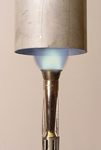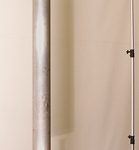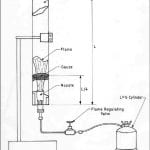- Fig 1
- Fig 2
- Fig 3
Equipment:
- Aluminum Pipe
- Bunsen Burner
- Metal Stand / Rod
- Metal Clamp (without rubber grips)
- Copper Mesh
- Heat Resistant Glove
- Glass Beaker
Demo:
Rijke’s pipe turns heat into sound by creating a self-amplifying standing wave. It is an entertaining phenomenon in acoustics and is an excellent example of resonance.
A sheet of copper wire mesh is inserted approximately a quarter of the way from the bottom of a metal tube (see Fig 3). Place the glass beaker under the tube to catch the hot mesh if it falls. Heat the mesh long enough to make it red-hot. Pull the burner away and the pipe will create a loud sound. The sound comes from the tube resonating at its fundamental frequency with a wavelength twice the length of the tube. There is no sound when the flame is heating the mesh or when the pipe is not upright.
Explanation:
The Rjike’s Pipe operates by two processes. The first is the creation of a standing wave in the pipe by the heat of the wire mesh expanding the air around it and the open top end of the tube cooling some of this air to condense back into the pipe. The second process is the constant upward convection currents created by the heat of the wire that propagate this standing wave.
First, in the Rijke’s Pipe about a quarter of the way in the lower half of the tube there is a piece of metal gauze which is heated by a propane torch. The air around the gauze is then also heated creating a pressure increase due to the ideal gas law:
As the air around the gauze is heated, it expands and rises, pushing air out of the top and bottom of the tube. As this hot air exits the tube and cools, it condenses and creates low pressure in the tube and just outside of the open ends. This low pressure causes some air to be sucked back into the tube. Most of this air is still warm from being pushed out of the tube, but some of the air has cooled much more and starts the process again as it’s heated by the gauze. This cyclical process generates a standing wave as seen in Fig 4.
This standing wave loses a lot of its energy to friction with the tube and with the air which is why the pipe doesn’t make a sound without one of its most important processes, the convection currents. These convection currents are caused by the constant heating of air around the hot gauze. Although some of this hot air is cooled and condensed back into the pipe, the rest of it rises out of the pipe, causing a loss of pressure in the pipe and therefore causing it to take in more cool air from the bottom of the pipe. This constant convection current helps propagate the standing wave by increasing the rising air currents within the pipe. With these upward currents, more air is forced out of the pipe creating lower pressure in the pipe, allowing for the propagation of the standing wave.

Fig 4: A pipe of length, L, with two open ends showing the fundamental frequency oscillating within it.
Therefore, the standing wave created in the pipe will resonate with a frequency of
which is the sound heard when the Bunsen burner is removed from underneath the pipe.
Interestingly, the pipe will not resonate when turned sideways or upside down. Since the convection will not move upwards through the pipe and therefore will not create a pressure differential within the pipe. This can easily be shown by turning the pipe sideways or upside down after heating the gauze.
Notes:
- Use a metal clamp without rubber grips to prevent the rubber grips from melting by the heat of the pipe
- If a new gauze is needed. Fold a small piece of thin copper mesh about 4 times until it’s slightly larger than the diameter of the tube. This should allow the mesh to be forced into the pipe so that it stays in one spot without falling through the pipe.
Written by Finn Amend


